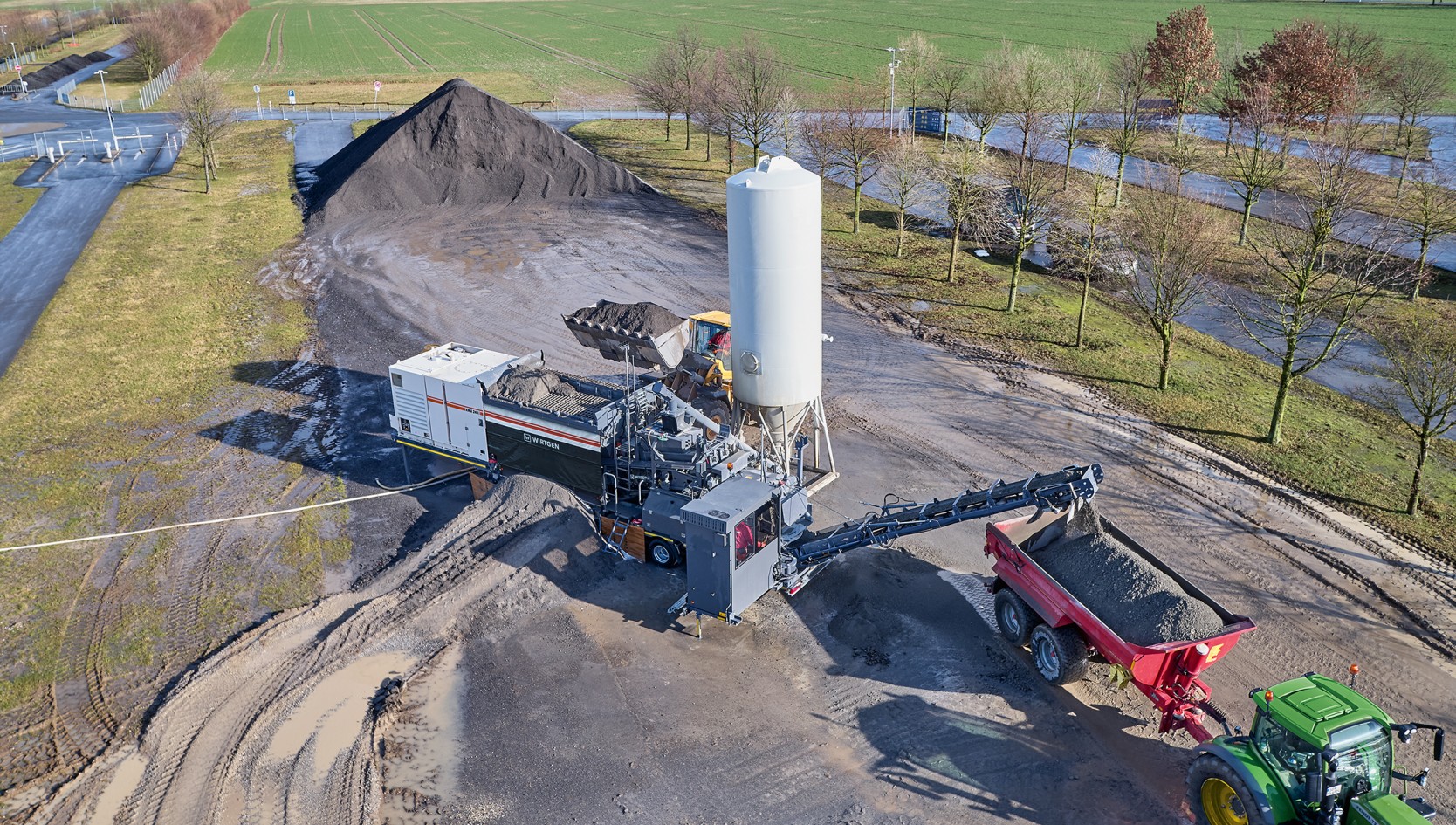Operating Principle of In-Plant Cold Recycling


The KMA 240(i) is mounted on a flatbed semitrailer and has its own motor station. This mobile design allows the system to be quickly moved to different locations and set up rapidly. Wheel loaders pour a wide variety of unbound raw materials into the proportioning hopper via vibrating grates. Silos or tank trucks supply the plant with binding agents such as cement, bitumen emulsion, or foamed bitumen. A microprocessor-controlled plant control system monitors the addition of raw materials and binding agents into the mixing chamber for high-precision dosing. Here, a heavy-duty twin-shaft pugmill produces a high-quality, homogeneous mix. Finally, the finished mix is smoothly loaded onto the swivel-mounted conveyor, which makes it possible to completely fill even long semitrailers.
The KMA 240(i) cold recycling mixing plant produces cold mix that can be paved immediately for a wide variety of construction projects, such as cement-treated base (CTB) layers for freeways. Due to the particularly generous, continuous addition of cement, enormous daily outputs can be achieved with maximum precision.
In addition to CTB and RCC (roller-compacted concrete), cold mix can be produced that is stabilized with bitumen emulsion or foamed bitumen (BSM).
The road surfaces produced from these high-quality cold mixes perform superbly due to their excellent bearing capacity, resistance to deformation, and long service life.
The highly mobile cold recycling mixing plant can be easily transported from site to site and quickly set up in the near vicinity. This saves time, truck capacity, and is also extremely environmentally friendly, making it possible to achieve up to 60% fewer CO2 emissions thanks to cold processing, a 90% reduction in transport volumes, and up to 50% lower total costs compared to conventional construction methods – in other words, an investment that pays off in every respect!
The well-engineered design allows the compact system to be easily and safely “packed up” onto a flatbed truck trailer and transported to the next site, saving both time and money. All you need to do is swivel in the discharge conveyor and operator’s cabin, move the cement charging auger to the transport position, and then hitch up the plant. A common truck is completely sufficient for transporting the plant as all of its connectors are standardized.
The compact transport dimensions and low overall weight of the KMA 240(i) comply with international traffic regulations, eliminating the time-consuming process of applying for special permits in most locations.
At first glance, the KMA 240(i) appears comparatively small. But when it comes to performance, the exact opposite is true – the compact machine packs a punch. Powered by a heavy-duty diesel engine, it can produce high-quality mix at an astonishing rate of 265 t / h (240 t / h). This mixing capacity even far exceeds that of many stationary large-scale plants.
But it doesn’t just come down to performance, a continuous supply of materials to the job site is also crucial.
This is guaranteed by the field-proven loading system of the KMA 240(i). The discharge conveyor features wide swing angles that make it possible to evenly fill semitrailer trucks.
With a capacity of 265 t / h (240 t / h), the machine produces a full truckload of 22 tons (20 tons) of mix every five minutes. This means that, for example, an enormous section of a cement-treated or bituminous bound base layer 13 ft 1 in (4.0 m) wide, 6 in (15 cm) thick, and 0.9 miles (1.4 km) long can be paved every day.
The main components of the plant – the material hopper, dosing units, and twin-shaft continuous mixer – mesh together perfectly, ensuring that the binding agents are added to the raw material weighed in the mixer precisely and simultaneously. The end result is a mix quality that precisely matches the required recipe.
The innovative double trough system features two independent, state-of-the-art weighing units. This allows cement to be dosed gravimetrically from one trough while the other trough is simultaneously being filled with more cement and precisely weighed. The alternating dosing process is carried out with the utmost precision and without interrupting the addition of binding agent.
